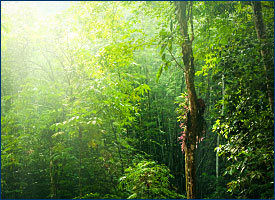Conservation Achieving It’s Goals?
Biological Miracles and Ecological Faith in the Future — Part 1
Is Conservation Achieving It’s Goals?
To glean but one example of the prolific nature of biodiversity, consider the ongoing data base from Ecuador’s Yasuni National Park, probably the single most biologically elegant fortress of interdependent life forms as yet discovered, with nearly six hundred bird species, 150 amphibian populations, “more tree species, 655″ in a single hectare (2.47 acres) than in all of the United States (and “1,100 for an area of 25 hectares”); and “more tree, shrub and liana (woody vines) species than anywhere else in the world,” according to Gorky Villa, an Ecuadorian botanist who has specialized in the area.
 Most impressive of all, there are projections (up from 60,000 in 1998) that as many as 100,000 insect species inhabit every hectare of Yasuni. At the Tiputini Biodiversity Station, a 1,600-acre research center on the northern side of the national park, there are a known “247 amphibian and reptile species, 550 bird species and around 200 mammal species.” The park also contains underground oil reserves (wouldn’t you know it) and Ecuador is not a rich country although the current administration has vowed to protect the park. (*See Margot S. Bass, Matt Finer, Clinton N. Jenkins, Holger Kreft, Diego F. Cisneros-Heredia, Shawn F. McCracken, Nigel C. A. Pitman, Peter H. English, Kelly Swing, Gorky Villa, Anthony Di Fiore, Christian C. Voigt, Thomas H. Kunz. “Global Conservation Significance of Ecuador’s Yasun’ National Park,” PLoS ONE, 2010; 5 (1): e8767 DOI: 10.1371/journal.pone.0008767)
Most impressive of all, there are projections (up from 60,000 in 1998) that as many as 100,000 insect species inhabit every hectare of Yasuni. At the Tiputini Biodiversity Station, a 1,600-acre research center on the northern side of the national park, there are a known “247 amphibian and reptile species, 550 bird species and around 200 mammal species.” The park also contains underground oil reserves (wouldn’t you know it) and Ecuador is not a rich country although the current administration has vowed to protect the park. (*See Margot S. Bass, Matt Finer, Clinton N. Jenkins, Holger Kreft, Diego F. Cisneros-Heredia, Shawn F. McCracken, Nigel C. A. Pitman, Peter H. English, Kelly Swing, Gorky Villa, Anthony Di Fiore, Christian C. Voigt, Thomas H. Kunz. “Global Conservation Significance of Ecuador’s Yasun’ National Park,” PLoS ONE, 2010; 5 (1): e8767 DOI: 10.1371/journal.pone.0008767)
Add to such data scientific findings from Singapore some years ago which indicated at least two co-symbiotic species dependent on every identified species and that 100,000 projection for Yasuni insects suddenly jumps to 300,000; and with every one of those 300,000, add another unknown quanta of endemic follicle mites, hair louse, bacteria, et cetera, and the Earth’s prolific palette becomes a great Impressionist picnic, infinite in its riches.
Yet, just as we discover such indescribable Creation, we bolster our age-old sense of self-enthrallment with the knowledge that at least five past global extinction events were “normal”; that the huge die out of the so-called “Age of Fishes” by 359 million years ago made way for opportunists on the fringes, from frogs to (eventually) Homo sapiens. This kind of relativism has raised the polemical heat in the room where politics and economics argue for oil extraction from such remarkable sites as Yasuni National Park. In March of 2010, 27 square miles of “high-value conservation land in national parks and other currently protected areas” across New Zealand were considered by the government as possible fair game for mining. (See www.ens-newswire.com/) Conservationists were “horrified” but the story is an old one: nothing is sacred. We are in trouble. The conservation conundrum comes down to the following: can we stem the tide of destruction, wake up, smell the roses, achieve full maturity as a collective, or are we doomed to write the most ephemeral, nonsensical epitaphs of any species? Is conservation achieving even a fraction of its goals? Teddy Roosevelt, who created the first Fish and Wildlife Reserve at Pelican Island in Florida in 1903 (a mere 5.3 acres which have since been eroded to fewer than 3 acres) for purposes of protecting Brown Pelicans, had gotten ecological patriotism and religion. Previously, he had exemplified the full machismo of the so-called Great White Hunter (later to be thought of as “professional hunters” who still have virtually free reign across a dozen African nations). The second President Roosevelt would commend Louis Bromfield (1896 to 1956) and his organic farming practices at Malibar Farm in Pleasant Valley, Ohio. Bromfield moved there in 1938, the year Jean-Paul Sartre published his most influential piece of fiction, Nausea.
Part 2: The Values of Conservation
Comments Off
